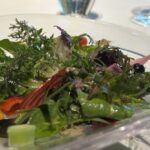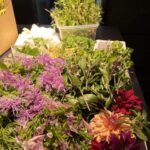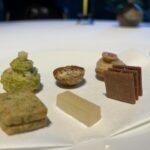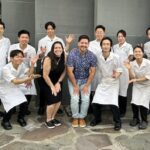
Justin staged at L'Efferverscence in Tokyo, Japan because it gave him the chance to hone his observational kitchen skills while immersed in a different working culture.
Ever since I can remember I have been fascinated with Japan and its culture. So naturally when I learned that I had been awarded a Ment’or Grant, I knew I wanted to pursue an experience learning inside a Japanese kitchen. Tokyo has a reputation as a world-class destination for literally all kinds of food and levels of service. Shinobu Namae was a name I read about before in food publications and press for Michelin and World’s 50 Best and I knew that his philosophy in using local products and strong advocacy for Japanese agriculture and producers was something that I identified with and wanted to see up close. Having trained abroad in London and France as well, I understood that Namae-san's approach to his cuisine as well as his kitchen culture would serve as an important bridge for me not only to be able to have a meaningful experience while working at L’Effervescence but also his unique perspective was something I wanted to be able to witness.
L’Efferverscence was open 5 days a week Tuesday to Saturday and served lunch and dinner each day, except for Tuesday that was dinner only, which helped the cooks build their mise en place for the rest of the week. While working at L’Effervescence I was, for the most part, the only stagiaire in the kitchen so I was able to help with prep and mise from all of the stations. At L’Effervescence there were 3 sections; garde manger, cuisson, and pâtissier. I was mainly stationed on garde manger with 3 other cooks and was primarily tasked with helping them prepare the mise en place for the salad which was the third of the ten-course menu; the “legumes” course. My typical day would usually start with picking/tearing the various salad greens then rinsing, cleaning, drying and storing them. Then during lunch and dinner service I would usually help the garde manger cooks prepare or mise out kits for the rest of the salad which would consist of picking and cleaning herbs and/or flowers, scrubbing, washing, or otherwise cleaning/portioning vegetables to be cooked, cutting various citrus or other fruit, slicing and pickling onion, and processing kombu for kombu powder amongst other projects. I was on rare occasions allowed to plate one of the dishes that came from the garde manger station, usually either the first course (the “bouquet” or chips course) or the salad course. Right before the staff meal I would assist the cooks in assembling the staff meal salad, begin scrubbing/cleaning the station, washing towels, and preparing the staff meal tea.
Family meal at L’Effervescsence was delicious and everyone took turns taking the lead on staff meal, but Ogawa-san's swordfish fry with roasted tomato salad and eggy tartar sauce was a standout for me! Finding moments to take out the trash or help wash, dry, and put away dishes was not only helpful but necessary and expected for all the cooks to participate in, as there were no dishwashers, porters or other support staff inside the kitchen, the cooks handled everything from receiving, inventory, prep, service, dishwashing, polishing, deep cleaning, taking out trash, even directly speaking with the farmers to decide when/what products they need or want delivered.
While in American kitchens and culture the focus is very much on the individual, in Japan its quite the opposite; Community comes first. At L’Effervescence everyone was expected to be willing and able to help one another out if there was something that needed to be done to be ready for service. Whatever the task, teamwork was the norm, and it was a given for help to be given if that was what was necessary. However, I will say that in Japan and in Japanese culture, the expectation is that of very high observational skills and that merely watching was sufficient to be able to then identify where/when to jump into helping execute a task or perform a new one. Another valuable lesson I learned while in Tokyo was how important sourcing ingredients really is. Namae-san takes very seriously the necessity and importance of supporting local producers and makes it a point to organize several field trips throughout the year to visit the farmers that the restaurant sources from. L’Effervescence also tries very hard to minimize its food waste. If there were ever anything that is unfit to use for a dish, it would then be used as food for staff meal. Throwing something away because it was inconvenient to process, had been allowed to rot, or was otherwise edible/usable was unheard of and not tolerated.
While working at L’Effervescence, I realized that practicing and steadily honing a skill is not only a worthwhile pursuit, but that building your skills is just the first step. Though, in Japan, I found that my consistent and diligent work was usually seen and rewarded, sometimes valued even more than the results themselves, which personally felt different and refreshing. Overall, I found that Japanese and French food cultures actually have a great deal in common. They both are rich in agricultural/animal products and have a vast geographical area that has allowed for the development of diverse and nuanced food traditions and preferences. After dining at L’Effervescence I can surely say, that while French technique and cuisine is the lens by which you view the rich bounty and incredibly high-quality products of Japan, the service is warm, subtle, and sincere; no doubt adhering to the famous Japanese principle of hospitality “Omotenashi”.



